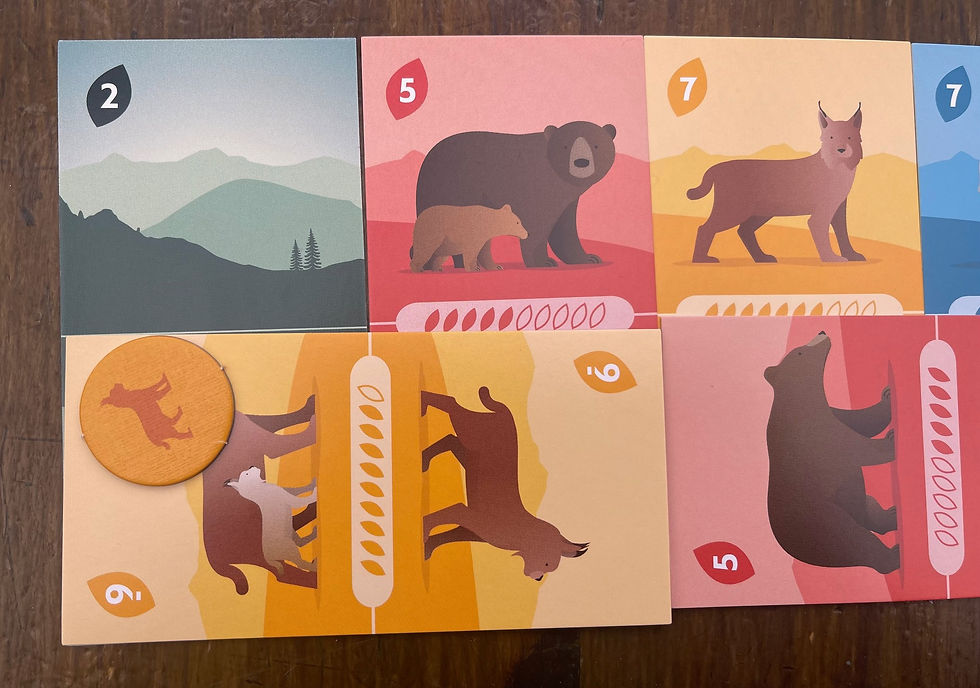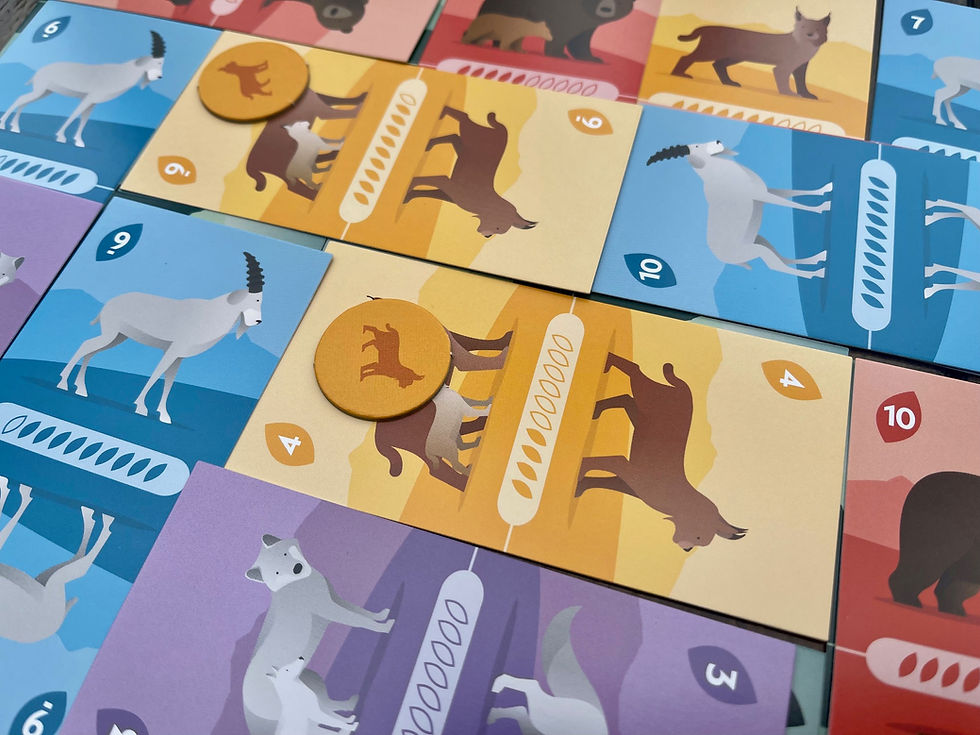Just Wild Card Game Review
- Jim Gamer
- Oct 23, 2023
- 6 min read
WBG Score: 7/10
Player Count: 2-4
You’ll like this if you like: Cascadia, Abstract Academy.
Published by: Helvetiq
Designed by: Leo Colovini, Marco Franchin
Distributed in the UK by: Coiledspring Games
This is a review copy. See our review policy here
Helvetiq makes small boxes full of joy. With Just Wild they seem to have turned their attention to promoting a very valid wildlife and environmental concern around four threatened
species native to mainland Europe. This has come about with a partnership with Salamandre, a non-profit French/Swiss publishing house. The plight of the Lynx, Wolf, Bear, and Ibex are detailed in the rulebook within a production that has been made with the highest environmental standards available. But is the game any good? Let's get it to the table and find out.

How To Set Up Just Wild
In the box you will fund a deck of 80 cards. 20 each for the four animals in the the game. The Lynx, Bear, Ibex, and Wolf. Each player chooses an animal to play as and takes their respective deck of cards. Each animal also has six tokens. Distribute these to each player based on their chosen animal as well. Each player then shuffles their deck and places their top card into a starting central area. Each card is placed in turn order, one at a time, touching each other adjacently, forming a rectangle. Each player then draws a starting hand of three cards and you are ready to play.
How To Play Just Wild
On each players turn one card must be played. This typically would be one card chosen from their hand of three cards, placed over the top of two other half cards. However, if a player cannot do this or chooses not to do this, then they must place a card face down on the table from the top of their deck.

Players are looking to form the biggest total of their chosen animals cards. At the end of the game, each face up animal for each player scores each player one point. But, each player ends the game at different times based on when their deck runs out.
When you place a card over the top of other cards, the card you are placing must be equal too or have a higher value than the cards it is covering. Each face up card has a number for each half, and the total of the two halves you are covering is totalled up, and you must be able to match or beat this in order to cover it over with your card.
The cards have value running from one to ten. Whenever you are covering two cards, and one of the halves has a ten, no card will be able to match or beat the total, as it will be above ten, and everyone's highest card is ten. In this situation, players can still cover the cards but must use two cards to do so. One from their hand as usual, and another taken from the top of their deck, placed face down.

Face down cards have a value too, and can be covered just like other cards. Typically they have lower values, and of course, do not show any animals artwork, so will not score any player any points.
When a player places their last card they will immediately score one point for each face up animal of their chosen type. The other players will then continue as usual until they run out of cards. If any player who has finished has any of the scored cards covered by players in later turns, this will not affect their score.
All players have a number of cards in their hands with artwork that shows their animal walking with an infant. Ten from their total deck of 20 in fact. When these are placed, players may choose if they wish to mark this half with a token. This means this half of the card is protected and cannot be covered by any card later in the game. You must choose carefully when to place these, thinking about which cards your opponents may try or want to cover. At the end of the game, when all players have placed all of their cards, the player with the most points is the winner.

Is It Fun? Just Wild Card Game Review
Before I come to the gameplay, I want to touch on the production. I applaud Helvetiq for creating such a sustainable and environmentally friendly product. It is clear from the slip case with no cellophane, and paper card holders, that everything has been considered with this production when it comes to being green. Well done to them for that.
It must be said though that this does affect the quality. The cards are quite thin and the tokens feel quite cardboardy. With such a small box production, I wonder if there could be a balance here. Or if there are other methods than can be employed that deliver the same impact on the environment but with a slightly better finish for the user? But, I do want to be clear, the components are fine. They are not bad. They are just not up to the usual Helvetiq standards. I mention this with caution as I understand what has been attempted here, and it feels that the world and our children's future is the bigger picture over card stock! I mention purely for honesty.

The gameplay however, absolutely is up to the usual Helvetiq standards. Like most Helvetiq games, this is incredibly easy to learn and teach, but still a lot of fun to play. I think it works best in a four player game. The two player is fine, and very fast. But does feel a little confrontational and full of take-that moments as you can only ever attack one other player. But in a three or four, where there is more choice and naturally a larger game area, the game opens up to more strategic choices. You don't want to let anyone run away with the lead, and as everyone has the same deck, games tend to be tight affairs, with all players being in with a chance right until the end.
Being able to play seems to be the key. If ever you have cards in hand that are not of a high enough value to cover two other half cards, you are forced to play a card face down from your deck, which essentially wastes a card. Being able to prevent this and keep as many of your cards face up on the table is how you do well. Which admittedly has some luck to it. You only ever have three cards in your hand after all. As such, I wander if a better variant of the game would have allowed players to hold five cards instead of three?

There is a lot of joy in creating little areas you can call your own though. Many board game designers seem to understand this and offer it within our hobby. Creating something, no matter how small or temporary feels good. Scoring that thing you have created gives your time some worth. Adding an see-saw nature to the control you have in what you can create by adding competitors makes it a game. With Just Wild, the elements of area majority have been distilled to its finest format and the result is an incredibly simple but fun game to play.
I wonder if there could be just one or two more wrinkles to the gam though. It feels a little too light. I like the opportunity to add the tokens, but wonder if the artwork could have brought in a few other variants with some of your animals being in packs, or perhaps with other powers that allowed more strategic choices. This is Cascadia light. A very good thing! But maybe just a little too light.
There is a delightful environmental message with this game though that must be applauded. Not just the theme and production, but also the preservation of the young animals over the old. Nurturing the next generation of these endangered species and putting more focus on the young. It has allowed for some wonderful conversations with my children that I otherwise might not have had.
I would reccomend this game to any young family who have an interest in conseration or the environemt and are looking for a new game to play as a group after tea that brings both fun and conversation to the table.


Comments